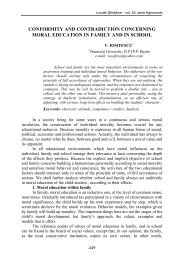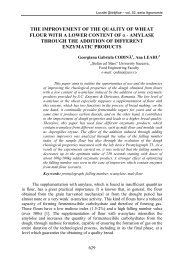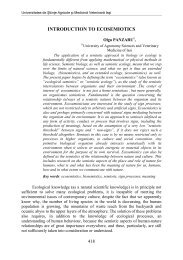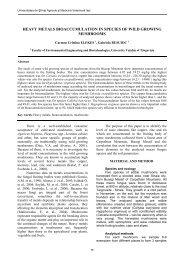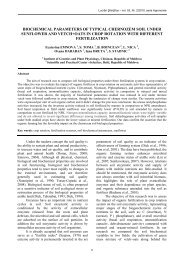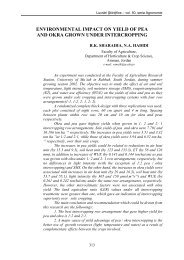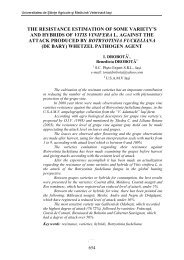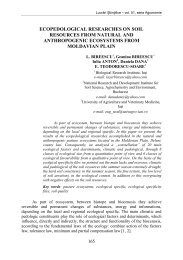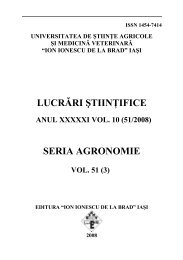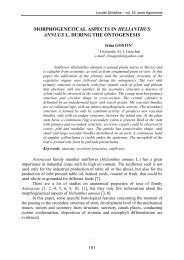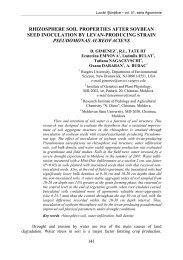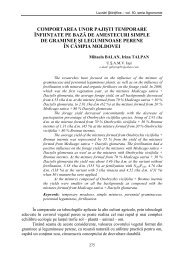effect of gluten vital on the alveograph charactersitics and bread ...
effect of gluten vital on the alveograph charactersitics and bread ...
effect of gluten vital on the alveograph charactersitics and bread ...
You also want an ePaper? Increase the reach of your titles
YUMPU automatically turns print PDFs into web optimized ePapers that Google loves.
Lucrări Ştiinţifice – vol. 51, seria Agr<strong>on</strong>omie<br />
ano<strong>the</strong>r forming a network. From <strong>the</strong> rheological point <str<strong>on</strong>g>of</str<strong>on</strong>g> view, <str<strong>on</strong>g>gluten</str<strong>on</strong>g>ins are<br />
characterized by a large elasticity <strong>and</strong> a low extensibility [3, 4, 5, 10, 12 ].<br />
The <str<strong>on</strong>g>gluten</str<strong>on</strong>g>ins have been studied by a large number <str<strong>on</strong>g>of</str<strong>on</strong>g> authors [1, 6, 7, 8, 10,<br />
12] <strong>and</strong> <strong>the</strong>ir important role has been c<strong>on</strong>firmed by many researches.<br />
The gliadins have been studied less than <str<strong>on</strong>g>gluten</str<strong>on</strong>g>ins, maybe because <strong>the</strong> focus<br />
was <strong>on</strong> explaining <strong>the</strong> <str<strong>on</strong>g>gluten</str<strong>on</strong>g>ins’ role <strong>on</strong> dough rheology, <strong>and</strong> especially <strong>on</strong> <str<strong>on</strong>g>gluten</str<strong>on</strong>g><br />
elasticity, property associated with <str<strong>on</strong>g>gluten</str<strong>on</strong>g>ins. Also gliadins have been less studied<br />
because <str<strong>on</strong>g>of</str<strong>on</strong>g> <strong>the</strong>ir heterogeneity <strong>and</strong> because <str<strong>on</strong>g>of</str<strong>on</strong>g> <strong>the</strong> large number <str<strong>on</strong>g>of</str<strong>on</strong>g> fracti<strong>on</strong>s which<br />
are very hard to associate in <strong>the</strong> pure state. If <str<strong>on</strong>g>gluten</str<strong>on</strong>g>ins have been associated with<br />
elasticity, gliadins are associated with viscosity <strong>and</strong> plasticity <str<strong>on</strong>g>of</str<strong>on</strong>g> <strong>the</strong> dough [1, 9].<br />
The basic principle <str<strong>on</strong>g>of</str<strong>on</strong>g> <str<strong>on</strong>g>gluten</str<strong>on</strong>g> usage in bakery derives from its ability to fit in<br />
perfectly with <strong>the</strong> <str<strong>on</strong>g>gluten</str<strong>on</strong>g>ic proteins in flour which has been additived, resulting a<br />
perfectly homogenous <strong>and</strong> stable <str<strong>on</strong>g>gluten</str<strong>on</strong>g>ic network.<br />
Vital <str<strong>on</strong>g>gluten</str<strong>on</strong>g> is obtained from wheat, through a specific technology which<br />
implies <strong>the</strong> separati<strong>on</strong> <str<strong>on</strong>g>of</str<strong>on</strong>g> <str<strong>on</strong>g>gluten</str<strong>on</strong>g> <strong>and</strong> starch in a water bath. The moist <str<strong>on</strong>g>gluten</str<strong>on</strong>g> is <strong>the</strong>n<br />
subjected to a c<strong>on</strong>trolled drying so that <strong>the</strong> native qualities are maintained. These<br />
qualities depend proporti<strong>on</strong>ally to <strong>the</strong> wheat’s quality from which <strong>the</strong> <str<strong>on</strong>g>gluten</str<strong>on</strong>g> is<br />
obtained, but also <strong>on</strong> drying parameters used in <strong>the</strong> separati<strong>on</strong> process.<br />
The additi<strong>on</strong> <str<strong>on</strong>g>of</str<strong>on</strong>g> <str<strong>on</strong>g>vital</str<strong>on</strong>g> <str<strong>on</strong>g>gluten</str<strong>on</strong>g> increases <strong>the</strong> technological potential <str<strong>on</strong>g>of</str<strong>on</strong>g> wheat<br />
flours up to a certain dose. The usual <str<strong>on</strong>g>gluten</str<strong>on</strong>g> c<strong>on</strong>tains 75% proteins, meaning that<br />
<strong>the</strong> increase in protein c<strong>on</strong>tent in flour from 10% to 12% would require <strong>the</strong> additi<strong>on</strong><br />
<str<strong>on</strong>g>of</str<strong>on</strong>g> 1,1 kilos <str<strong>on</strong>g>of</str<strong>on</strong>g> <str<strong>on</strong>g>gluten</str<strong>on</strong>g> for 100 kilos <str<strong>on</strong>g>of</str<strong>on</strong>g> flour. Because <str<strong>on</strong>g>of</str<strong>on</strong>g> <strong>the</strong> poor functi<strong>on</strong>ality <str<strong>on</strong>g>of</str<strong>on</strong>g><br />
<strong>the</strong> protein in <str<strong>on</strong>g>gluten</str<strong>on</strong>g>, in reality 1,8 kilos <str<strong>on</strong>g>of</str<strong>on</strong>g> <str<strong>on</strong>g>gluten</str<strong>on</strong>g> would be required for 100 kilos<br />
<str<strong>on</strong>g>of</str<strong>on</strong>g> flour to get <strong>the</strong> same <str<strong>on</strong>g>effect</str<strong>on</strong>g>. In many countries it is added in c<strong>on</strong>centrati<strong>on</strong>s <str<strong>on</strong>g>of</str<strong>on</strong>g> 1<br />
to 5% to increase <strong>the</strong> <str<strong>on</strong>g>gluten</str<strong>on</strong>g> quantity <str<strong>on</strong>g>of</str<strong>on</strong>g> flour <strong>and</strong> to ensure <strong>the</strong> right texture <strong>and</strong><br />
volume, especially for <strong>the</strong> products where a large quantity <str<strong>on</strong>g>of</str<strong>on</strong>g> additives, like soy<br />
flour, milk powder, rye flour is added.<br />
As a raw material <str<strong>on</strong>g>of</str<strong>on</strong>g> vegetal origin for protein products making, <str<strong>on</strong>g>gluten</str<strong>on</strong>g> is<br />
sec<strong>on</strong>d after soy flour, with an ever increasing dem<strong>and</strong> lately.<br />
MATERIAL AND METHOD<br />
The experiments <strong>the</strong>re have chosen flour with a weaker potential for <strong>bread</strong>making<br />
as raw material. C<strong>on</strong>trol flour was analyzed by performing Romanian st<strong>and</strong>ard<br />
methods: STAS 6124-73, STAS 90-88, STAS 6283-83 <strong>and</strong> SR ISO 3093:1997. In<br />
experiments, a flour with 13.9% moisture, <strong>and</strong> 10.72% crude protein c<strong>on</strong>tent was used.<br />
The determined values for physical-chemical properties are menti<strong>on</strong>ed as following:<br />
ash c<strong>on</strong>tent 0.64%, wet <str<strong>on</strong>g>gluten</str<strong>on</strong>g> c<strong>on</strong>tent 23.8%, <str<strong>on</strong>g>gluten</str<strong>on</strong>g> deformati<strong>on</strong> 13 mm, <strong>and</strong> falling<br />
number 255s. Data acknowledge that <strong>the</strong> c<strong>on</strong>trol flour has a weaker potential for <strong>bread</strong>making<br />
from that <strong>the</strong> point <str<strong>on</strong>g>of</str<strong>on</strong>g> view.<br />
Starting from chosen flour for analyses, different samples <str<strong>on</strong>g>of</str<strong>on</strong>g> flour were used in<br />
experiments, improved with different doses <str<strong>on</strong>g>of</str<strong>on</strong>g> <str<strong>on</strong>g>vital</str<strong>on</strong>g> <str<strong>on</strong>g>gluten</str<strong>on</strong>g> (1%, 2%, 3%, 4%, 5%).<br />
The rheological behavior <str<strong>on</strong>g>of</str<strong>on</strong>g> <strong>the</strong> dough prepared from wheat flour was carried out<br />
<strong>on</strong> Chopin <strong>alveograph</strong> according to SR ISO 5530.<br />
107




